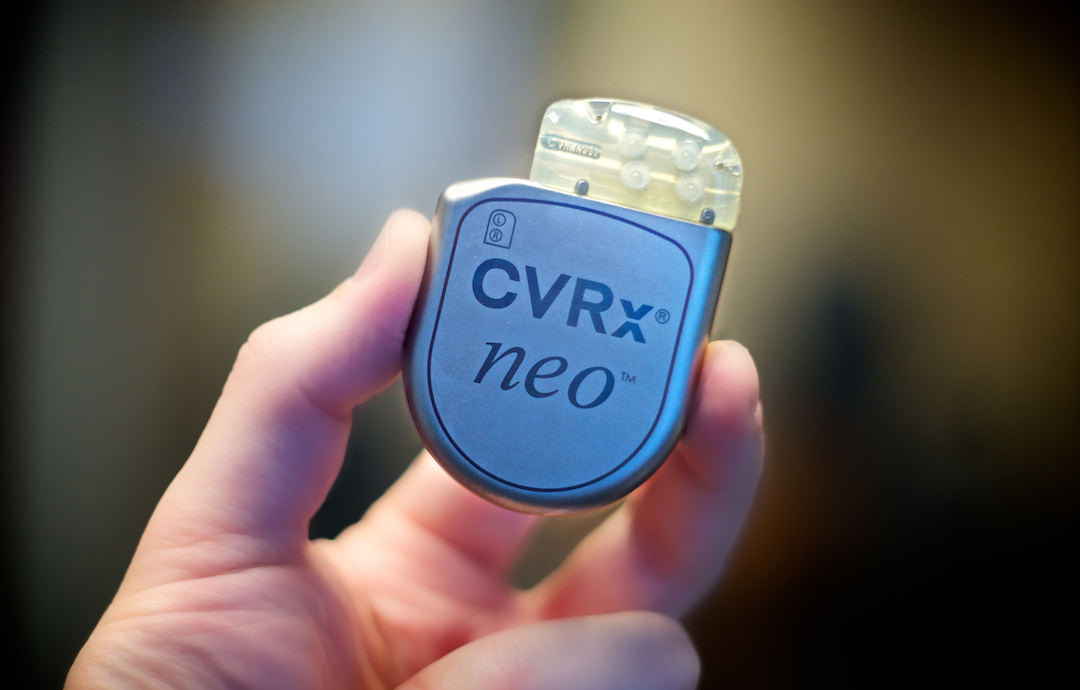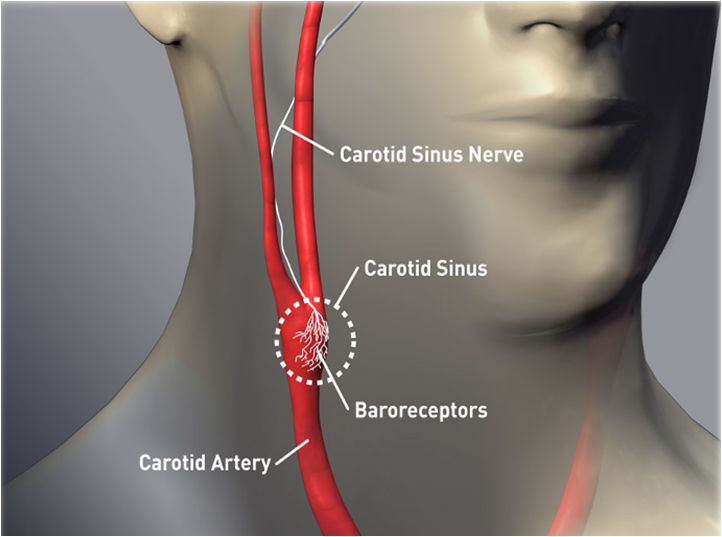
Similar to a pacemaker, the Barostim Neo System uses a pulse generator implanted below the collar bone with a lead that attaches to the carotid artery in the neck. It delivers electrical impulses to baroreceptors in the neck, which sense how blood is flowing through the carotid arteries and relays information to the brain. The brain, in turn, sends signals to the heart and blood vessels that relax the blood vessels and inhibit the production of stress-related hormones to reduce heart failure symptoms.
August 19, 2019 — The U.S. Food and Drug Administration (FDA) granted market clearance the Barostim Neo System for the improvement of symptoms in patients with advanced heart failure who are not suited for treatment with other heart failure devices, such as cardiac resynchronization therapy. The FDA gave the device a Breakthrough Device designation because it treats a life-threatening disease, heart failure, and addresses an unmet medical need in patients who fail to get adequate benefits from standard treatments and have no alternative treatment options.
 “Patients with advanced heart failure have limitations of physical activity, experiencing fatigue, palpitation or shortness of breath with activity and may not benefit from standard treatments, including currently marketed drugs and devices. This approval provides patients with a new treatment option for the symptoms associated with advanced heart failure,” said Bram Zuckerman, M.D., director of the Office of Cardiovascular Devices in the FDA’s Center for Devices and Radiological Health. “The FDA continues to work with manufacturers through our Breakthrough Devices Program to provide patients and healthcare providers with timely access to medical devices that have the potential to lead to a clinical improvement in patients, such as those with this irreversibly debilitating condition, while ensuring these devices meet our regulatory requirements for safety and effectiveness.”
“Patients with advanced heart failure have limitations of physical activity, experiencing fatigue, palpitation or shortness of breath with activity and may not benefit from standard treatments, including currently marketed drugs and devices. This approval provides patients with a new treatment option for the symptoms associated with advanced heart failure,” said Bram Zuckerman, M.D., director of the Office of Cardiovascular Devices in the FDA’s Center for Devices and Radiological Health. “The FDA continues to work with manufacturers through our Breakthrough Devices Program to provide patients and healthcare providers with timely access to medical devices that have the potential to lead to a clinical improvement in patients, such as those with this irreversibly debilitating condition, while ensuring these devices meet our regulatory requirements for safety and effectiveness.”
About 5.7 million people in the United States have heart failure, a condition in which the heart cannot pump enough blood to meet the body’s needs. The leading causes of heart failure are diseases that damage the heart, such as high blood pressure and diabetes. Treatment for heart failure includes treating the underlying causes and reducing symptoms such as fatigue and swelling in the lower extremities that make physical activity difficult. Doctors may prescribe medications like angiotensin converting enzyme (ACE) inhibitors, angiotensin receptor blockers or beta blockers to lower blood pressure and reduce strain on the heart, as well as diuretics to reduce fluid buildup in the lungs and swelling in the feet and ankles.
 The Barostim Neo System includes a pulse generator that is implanted below the collar bone and is connected to a lead that attaches to the carotid artery in the neck. After the device is implanted, a physician tests and programs the device, which delivers electrical impulses to cells in the neck called baroreceptors, which sense how blood is flowing through the carotid arteries and relays information to the brain. The brain, in turn, sends signals to the heart and blood vessels that relax the blood vessels and inhibit the production of stress-related hormones to reduce heart failure symptoms.
The Barostim Neo System includes a pulse generator that is implanted below the collar bone and is connected to a lead that attaches to the carotid artery in the neck. After the device is implanted, a physician tests and programs the device, which delivers electrical impulses to cells in the neck called baroreceptors, which sense how blood is flowing through the carotid arteries and relays information to the brain. The brain, in turn, sends signals to the heart and blood vessels that relax the blood vessels and inhibit the production of stress-related hormones to reduce heart failure symptoms.
The FDA evaluated data from a prospective, multi-center, two-arm, randomized clinical trial with a total of 408 patients with advanced heart failure. All patients received guideline-directed medical therapy, including medication, and 125 patients also received a Barostim Neo System implant. Patients receiving the implant showed improvements in the distance they were able to walk in six-minute walking tests and improvements in how symptoms impacted their quality of life. Also in the trial, 120 randomized subjects with less severe chronic heart failure found benefit in lowering levels of a biomarker that measures heart failure.
Potential complications associated with the implantation or use of the device include: infection; need for reoperation; low blood pressure that may cause dizziness, fainting, and/or falls; nerve damage; surgical or anesthetic complications; allergic reaction; arterial damage; exacerbation of heart failure; stroke; and death.
The Barostim Neo System is indicated for patients who have a regular heart rhythm, are not candidates for cardiac resynchronization therapy, and have a left ventricular ejection fraction (the total amount of blood pumped out in each heart beat) of less than or equal to 35 percent, which is considered below the normal ejection fraction of 55 to 75 percent. The device is contraindicated for patients with anatomy that would impair implantation of the device, certain nervous system disorders, uncontrolled and symptomatic slow heart rate, atherosclerosis or ulcerative plaques near the implant location, and patients with a known allergy to silicone or titanium.
The device was approved using the Premarket Approval (PMA) pathway. Premarket approval is the most stringent type of device marketing application required by the FDA and is based on a determination by the FDA that the PMA application contains sufficient valid scientific evidence to provide reasonable assurance that the device is safe and effective for its intended use(s).
As part of the approval of this device, the FDA is requiring the manufacturer to conduct a post-approval study investigating the potential of the therapy to prolong life and reduce the need for patient hospitalization.
The FDA granted the Barostim Neo System a Breakthrough Device designation, meaning the agency provided intensive interaction and guidance to the company on efficient device development, to expedite evidence generation and the agency’s review of the device. To qualify for such designation, a device must provide for more effective treatment or diagnosis of a life-threatening or irreversibly debilitating disease or condition. All designated devices must meet one of the following criteria: the device must represent a breakthrough technology; there must be no approved or cleared alternatives; the device must offer significant advantages over existing approved or cleared alternatives; or the availability of the device is in the best interest of patients.
The FDA granted approval of the Barostim Neo System to CVRx Inc.
For more information: www.cvrx.com
Related Barostim Content:
Device Technologies to Reduce Heart Failure Readmissions
FDA Grants HDE For Pacemaker That Regulates Hypertension
CVRx Barostim Therapy Clinical Trial Results Presented at ESC-Heart Failure Conference
First Implant Made for Barostim neo Device to Treat Hypertension
Barostim Therapy Projected to be Cost-Effective in Treating Resistant Hypertension


 February 14, 2022
February 14, 2022 




